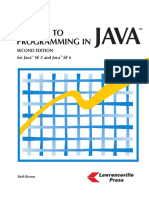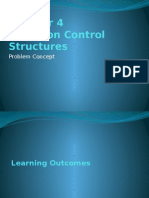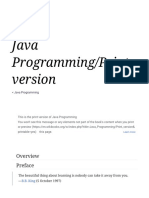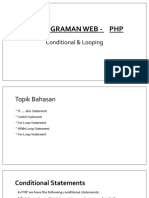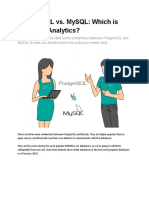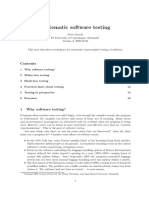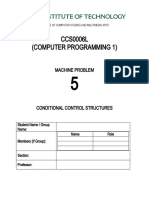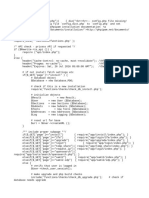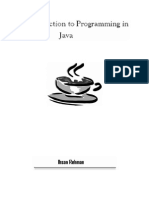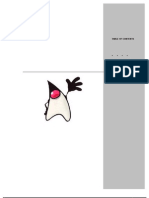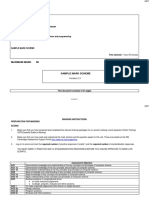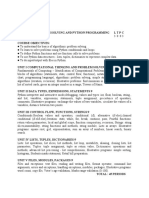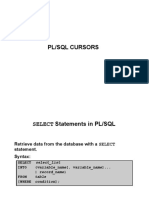A Guide To Programming in Java Java 2 Platform Standard Edition 5 Beth Brown Ready To Read
Uploaded by
jakellinet1536A Guide To Programming in Java Java 2 Platform Standard Edition 5 Beth Brown Ready To Read
Uploaded by
jakellinet1536A Guide To Programming in Java Java 2 Platform
Standard Edition 5 Beth Brown instant download
https://ebookgate.com/product/a-guide-to-programming-in-java-
java-2-platform-standard-edition-5-beth-brown/
★★★★★
4.8 out of 5.0 (17 reviews )
PDF Available Immediately
ebookgate.com
A Guide To Programming in Java Java 2 Platform Standard
Edition 5 Beth Brown
EBOOK
Available Formats
■ PDF eBook Study Guide Ebook
EXCLUSIVE 2025 ACADEMIC EDITION – LIMITED RELEASE
Available Instantly Access Library
Instant digital products (PDF, ePub, MOBI) available
Download now and explore formats that suit you...
Java 2 micro edition Java in small things James White
https://ebookgate.com/product/java-2-micro-edition-java-in-small-
things-james-white/
ebookgate.com
Programming in Java 2nd edition Edition Choudhary
https://ebookgate.com/product/programming-in-java-2nd-edition-edition-
choudhary/
ebookgate.com
Java 2 A Beginner s Guide 2nd Edition Steven Holzner
https://ebookgate.com/product/java-2-a-beginner-s-guide-2nd-edition-
steven-holzner/
ebookgate.com
Java Programming 8th Edition Joyce Farrell
https://ebookgate.com/product/java-programming-8th-edition-joyce-
farrell/
ebookgate.com
Java Programming 6th Edition Joyce Farrell
https://ebookgate.com/product/java-programming-6th-edition-joyce-
farrell/
ebookgate.com
Google Web Toolkit GWT Java AJAX Programming A Practical
Guide to Google Web Toolkit for Creating AJAX Applications
with Java 1st Ed. Edition Prabhakar Chaganti
https://ebookgate.com/product/google-web-toolkit-gwt-java-ajax-
programming-a-practical-guide-to-google-web-toolkit-for-creating-ajax-
applications-with-java-1st-ed-edition-prabhakar-chaganti/
ebookgate.com
Functional Programming in Java Harnessing the Power Of
Java 8 Lambda Expressions 1st Edition Venkat Subramaniam
https://ebookgate.com/product/functional-programming-in-java-
harnessing-the-power-of-java-8-lambda-expressions-1st-edition-venkat-
subramaniam/
ebookgate.com
Component Development for the Java Platform 1st Edition
Stuart Dabbs Halloway
https://ebookgate.com/product/component-development-for-the-java-
platform-1st-edition-stuart-dabbs-halloway/
ebookgate.com
Pentaho Reporting 3 5 for Java Developers Gorman
https://ebookgate.com/product/pentaho-reporting-3-5-for-java-
developers-gorman/
ebookgate.com
A Guide to Programming
in Java™
Java™ 2 Platform Standard Edition 5
Beth Brown
Copyright 2005
by
First Edition
ISBN 1-58003-071-8 (softcover)
ISBN 1-58003-072-6 (hardcover)
All rights reserved. No part of this work covered by the copyright may be reproduced or used
in any form or by any means—graphic, electronic, or mechanical, including photocopying,
recording, taping, or information storage and retrieval systems—without the written permission
of the publisher, with the exception of programs, which may be entered, stored, and executed
in a computer system, but not reprinted for publication or resold in any other form.
Printed in the United States of America
All orders including educational, Canadian, foreign,
FPO, and APO may be placed by contacting:
Lawrenceville Press, Inc.
P.O. Box 704
Pennington, NJ 08534-0704
(609) 737-1148
(609) 737-8564 fax
This text is available in hardcover and softcover editions.
16 15 14 13 12 11 10 9 8 7 6 5 4 3 2 1
The text is written and published by Lawrenceville Press, Inc. and is in no way
connected with the Sun® Corporation.
Sun®, Sun® Microsystems, and Java™ are trademarks or registered trademarks of
Sun Microsystems, Inc. in the United States and other countries.
Microsoft® Microsoft® Windows®, Visual Basic®, and Microsoft® Calculator are
either registered trademarks or trademarks of Microsoft Corporation in the United
States and/or other countries. Screen Shots and Icons reprinted with permission
from Microsoft® Corporation.
Mac OS® and Tiger™ are registered trademarks of Apple Computer, Inc. in the
United States and other countries.
ExamView is a registered trademark of FSCreations, Inc.
“JUNE BUGS” poem by Avis Harley used with permission from Boyds Mills Press.
Names of all other products mentioned herein are used for identification purposes
only and may be trademarks of their respective owners.
Preface
W e have strived to make this the clearest and most comprehensive
Java text available. Our primary objective in this text is to present mate-
rial in clear language with easy to follow examples. To meet this objective,
we use our teaching experiences as well as the feedback, comments, and
suggestions from other experienced instructors to determine how best to
present programming concepts.
For the best classroom experience for both the student and the instructor,
our comprehensive text book includes hands-on reviews, critical-thinking
questions, and exercises of varying difficulty levels. Additionally, our
Teacher Resource Materials correlate directly to the text book and offer
teaching hints for explaining difficult concepts, additional lessons and
exercises, and a comprehensive question bank for creating tests, quizzes,
and reviews. The Teacher Resource Materials include the applications,
Case Studies, and vocabulary from the text book, as well as answers to
all the reviews and exercises.
It is our belief that learning to program offers the student an invaluable
opportunity to develop problem-solving skills. The process of defining a
problem, breaking it down into a series of smaller problems, and finally
writing an application to solve it exercises a student’s logical abilities.
Additionally, the student is made aware of the capabilities and limita-
tions of a computer and soon realizes that the programmer—the human
element—is more important than the machine.
A Guide to Programming in Java is written for a one-term or two-term
course. No previous programming experience is required or assumed. It
is our goal that this text provide students the best possible introduction
to programming using Java and to prepare them for further study in the
IT/programming/computer science field.
Preface iii
Design and Features
Programming Concepts This text emphasizes the fundamental concepts
of programming so that this knowledge can be applied to other program-
ming languages.
Problem Solving From the very beginning, students are taught to imple-
ment programming solutions with proper algorithm design and code
conventions.
Programming Style Throughout the text, proper programming style
is emphasized so that students can make their applications easy to read,
modify, and debug.
Demonstration Applications and Runs Many demonstration applica-
tions are included, complete with sample runs, so that students are shown
both proper programming techniques and the output actually produced
by an application.
Reviews Numerous reviews are presented throughout each chapter to
provide immediate reinforcement of newly learned concepts. Solutions to
the reviews are included on the Teacher Resource Materials CD.
Case Studies Most chapters end by stating a problem, developing an
appropriate algorithm, and then implementing the solution. The process
of specification, design, implementation, and debugging and testing is
clearly outlined.
Chapter Summaries Each chapter ends by summarizing the concepts
and statements covered in the chapter.
Vocabulary Sections Each chapter contains a vocabulary section that
defines new terms. A separate section lists Java keywords, statements,
and classes.
Critical Thinking Written response questions that require critical think-
ing from the student are included at the end of each chapter.
Exercises Each chapter includes a large set of exercises of varying diffi-
culty, making them appropriate for students with a range of abilities. Most
exercises include a demonstration run to help make clear what output is
expected from the student’s application. Exercises based on previous work
are marked with a ö symbol. Answers to the exercises are included on
the Teacher Resource Materials CD.
Indexes In addition to a standard index, an index of the applications
presented in the text is also included.
Appendix A chart of Unicode symbols is included.
Online Resources Materials that complement and extend this text are free
for download and distribution in your class. Information about various
Java compilers is available. Supplemental chapters cover operating systems,
personal finances, introduction to computers, and keyboarding skills are
also provided. Students can download all the files needed to complete the
reviews and exercises from www.lpdatafiles.com.
iv A Guide to Programming in Java
Teacher Resource Materials
Our Teacher Resource Materials correlate directly to the text book and
provide all the additional materials required to offer students an excellent
computer applications course. The Teacher Resource Materials feature:
• START_HERE.htm Help files and a guide for using the text and
resource materials.
• Lesson Plans Lessons in PDF format keyed to the chapters in the
text. Each lesson includes assignments, teaching notes, worksheets,
and additional topics.
• Tutorials Flash movie files that provide animations to illustrate
searching and sorting concepts. Each movie is keyed to the text.
• PowerPoint Presentations Topics keyed to the text are in
PowerPoint files for presentation.
• Vocabulary Word files of the vocabulary presented in the text.
• Rubrics Rubrics keyed to exercises in the text for assessment.
• Worksheets Programming assignments that supplement the exer-
cises in the text provide additional reinforcement of concepts.
• Critical Thinking Answers Answers for the critical thinking
questions presented in the text.
• Data files All the files the student needs to complete the reviews
and exercises in the text, as well as the files needed to complete
the worksheets and tests.
• ExamView® Software Question banks keyed to the text and the
popular ExamView® software are included to create tests, quizzes,
and additional assessment materials.
• Answer files Answers to the reviews, exercises, worksheets, and
tests.
Acknowledgments
Special thanks to the many instructors who used this text in their
classroom as it was being written. I would especially like to thank the
following instructors for their many comments and suggestions:
Paul Massey Hanna-Westside Extension Campus
Edward Sapienza Peabody Veterans Memorial High School
Timothy Strohm Churchville-Chili Senior High School
Jackie Kyger Marine Military Academy
Jan Marrelli, a Lawrenceville Press author and editor, has contributed
much to this text. She has used this text as it was being written in her
classroom. The many comments and suggestions from her and her stu-
dents have helped to make this text so clearly written. Jan, an experienced
instructor, has also written many of the critical thinking questions, exer-
cises, and reviews.
Preface v
Elaine Malfas, senior technical editor at Lawrenceville Press, has pro-
duced the format and layout for this text. The many illustrations have been
created by Elaine as well.
Thanks also to Joseph Dupree in our Customer Relations Department
for some of the original drawings included in this text.
The success of this and all of our texts is due to the efforts of Heidi Crane,
Vice President of Marketing at Lawrenceville Press. Joseph Dupree and
Christina Albanesius run our Customer Relations Department and handle
the thousands of orders we receive in a friendly and efficient manner.
Michael Porter is responsible for the excellent service Lawrenceville Press
offers in the shipping of orders.
About the Author
Beth A. Brown, a Computer Science graduate of Florida Atlantic
University, is director of development at Lawrenceville Press where she
has coauthored a number of programming and applications texts and
their accompanying Teacher Resource Materials. She has taught computer
applications and programming at the high school level.
vi A Guide to Programming in Java
Chapter Expectations
Chapter 1 – An Introduction to Chapter 3 – Introducing Java
Computers After completing Chapter 3, students
After completing Chapter 1, students will be able to:
will be able to: 1. Define terminology associated with object-
1. Compare and contrast various input, output, oriented programming.
and storage devices. 2. Explain why Java is a widely used
2. Identify hardware components and explain programming language.
their function. 3. Create Java applications.
3. Demonstrate knowledge of operating systems. 4. Describe the process involved in executing a
4. Discuss different computer classifications and Java application.
compatibility issues. 5. Display and format program output.
5. Differentiate among the levels of programming 6. Annotate code properly with comments,
languages. formatting, and indentation.
6. Describe communication and networking 7. Explain the importance of using code
components. conventions.
7. Understand the binary number system. 8. Demonstrate algorithm design as a problem-
8. Describe how data is stored in memory and in solving strategy.
files. 9. Use visual organizers to design solutions.
9. Use Internet services to access information and
share resources. Chapter 4 – Variables and Constants
10. Demonstrate proper etiquette and knowledge After completing Chapter 4, students
of acceptable use policies when using a will be able to:
network. 1. Declare and initialize variables and constants
11. Discuss social and ethical issues associated using the appropriate data type.
with computer use. 2. Choose legal identifiers that follow good
programming style.
Chapter 2 – Applets and Web 3. Differentiate between primitive and abstract
Programming data types.
After completing Chapter 2, students 4. Explain how to access Java packages.
will be able to: 5. Demonstrate how to read data from an input
1. Define terminology associated with the World stream.
Wide Web. 6. Write numeric expressions.
2. Discuss the impact of programming on the 7. Apply type casting.
World Wide Web community. 8. Format numeric output.
3. Create HTML documents. 9. Identify Java keywords.
4. Explain how a web browser interprets an 10. Differentiate between syntax and logic errors.
HTML document. 11. Understand run-time exceptions.
5. Use JavaScript to demonstrate how scripts can 12. Read and understand a problem description,
enhance a website. purpose, and goals.
6. Create simple Java applets.
7. Specify custom values for a Java applet that has
been placed in an HTML document.
8. Apply a style sheet to an HTML document.
Preface vii
Chapter 5 – Conditional Control Chapter 8 – Classes and Object-
Structures Oriented Development
After completing Chapter 5, students After completing Chapter 8, students
will be able to: will be able to:
1. Demonstrate the use of decision structures to 1. Understand and instantiate objects.
control the flow of a program. 2. Design and implement a class.
2. Describe how a roundoff error can occur. 3. Apply functional decomposition.
3. Generate random numbers. 4. Apply appropriate naming conventions to a
4. Write compound Boolean expressions. class.
5. Access methods in the Math class. 5. Explain the difference between accessor,
6. Modify existing code. modifier, and helper methods.
7. Develop code with correct and efficient use of 6. Write constructors.
conditional control structures. 7. Compare and contrast instance and class
8. Select appropriate test data. members.
9. Create and modify solutions to problems. 8. Understand class specifications and the
relationships among the classes.
Chapter 6 – Loop Structures and 9. Understand and implement a given class
hierarchy.
Strings 10. Apply encapsulation.
After completing Chapter 6, students
11. Identify reusable code from existing code.
will be able to:
1. Demonstrate the use of repetition control
structures. Chapter 9 – Inheritance and
2. Explain how infinite loops can occur. Polymorphism
3. Differentiate between counters and After completing Chapter 9, students
accumulators. will be able to:
4. Use various tools and techniques to debug an 1. Extend a class using inheritance.
application. 2. Explain an is-a relationship.
5. Manipulate and compare strings using the 3. Implement a subclass.
String class and its methods. 4. Define and demonstrate polymorphism.
6. Develop code with correct and efficient use of 5. Understand abstract classes.
repetitive control structures. 6. Declare and implement an interface.
7. Apply problem solving strategies. 7. Extend existing code using inheritance.
Chapter 7 – Chapter Methods Chapter 10 – Arrays
After completing Chapter 7, students After completing Chapter 10, students
will be able to: will be able to:
1. Use top-down development and procedural 1. Describe types of problems that benefit from
abstraction to develop problem solutions. the use of arrays.
2. Write methods. 2. Create one and two dimensional arrays.
3. Use method parameters. 3. Include array parameters in a method
4. Demonstrate the use of method overloading. declaration.
5. Return values from a method. 4. Understand how to implement arrays with
6. Write appropriate method documentation, meaningful indexes.
including pre- and post-conditions. 5. Apply offset array indexes.
7. Identify boundary cases and generate 6. Manipulate characters in a string.
appropriate test data. 7. Understand the digital code, Unicode.
8. Describe code conventions that apply to 8. Apply search algorithms to an array.
methods. 9. Use methods in the ArrayList class.
10. Demonstrate the use of the Wrapper classes.
viii A Guide to Programming in Java
Visit https://ebookgate.com today to explore
a vast collection of ebooks across various
genres, available in popular formats like
PDF, EPUB, and MOBI, fully compatible with
all devices. Enjoy a seamless reading
experience and effortlessly download high-
quality materials in just a few simple steps.
Plus, don’t miss out on exciting offers that
let you access a wealth of knowledge at the
best prices!
Chapter 11 – GUIS and Event-Driven Chapter 14 – Data Structures
Programming After completing Chapter 14, students
After completing Chapter 11, students will be able to:
will be able to: 1. Explain how data structures, such as stacks
1. Design graphical user interfaces. and queues, can be used to organize data.
2. Use component classes in the Java swing 2. Use and implement well known data
package. structures.
3. Create event-driven applications. 3. Describe standard operations associated with
data structures.
4. Control the layout of an interface using layout
managers. 4. Choose appropriate data structures.
5. Use text fields and combo boxes to obtain user 5. Differentiate between a LIFO and FIFO
input. structure.
6. Apply color and add images to an interface.
Chapter 12 – Files and Exception
Handling
After completing Chapter 12, students
will be able to:
1. Use the File class to create objects that
represent a file.
2. Write exception handlers.
3. Understand file streams.
4. Read the contents of an existing file.
5. Process numeric data.
6. Create an output file stream.
7. Explain the object serialization and
deserialization processes.
Chapter 13 – Recursion and
Advanced Algorithms
After completing Chapter 13, students
will be able to:
1. Implement the selection sort algorithms.
2. Sort objects using the Comparable interface.
3. Implement the insertion sort algorithm.
4. Define and demonstrate recursion.
5. Implement the mergesort algorithm.
6. Implement the binary search algorithm.
7. Explain the recursive technique, depth-first
searching.
8. Analyze algorithms for efficiency.
9. Design and document sequential search
algorithms.
Preface ix
x A Guide to Programming in Java
Table of Contents
Chapter 1 – An Introduction to Chapter 2 – Applets and Web
Computers Programming
Desktop Computing .................................................1 The World Wide Web.............................................. 35
Operating Systems and Environment ....................2 HTML ...................................................................... 36
Mobile Computing ....................................................4 Creating an HTML Document .............................. 37
Programming Languages ........................................5 Review: hello_world.htm .................................. 38
Networks .................................................................... 6 Review: Computer Viruses Website –
Number Systems .......................................................9 part 1 of 6 ............................................................. 38
Storing Data in Memory ........................................ 10 JavaScript .................................................................. 38
What is a File? ......................................................... 11 Review: welcome.htm........................................ 39
Storage Devices........................................................ 12 Review: Computer Viruses Website –
Intranet, Extranet, Internet .................................... 13 part 2 of 6 ............................................................. 39
Telecommunications ............................................... 14 Using Scripts to Enhance a Website ..................... 40
Internet Services: Web, E-mail, and Review: Computer Viruses Website –
Mailing Lists ............................................................ 15 part 3 of 6 ............................................................. 41
Finding Information on the Web and Review: System Check – part 1 of 2 ................. 41
Downloading Files .................................................. 16 Java Applets ............................................................. 41
Internet Privacy Issues ........................................... 18 Creating Java Applets ............................................. 41
Internet Acceptable Use Policy ............................. 19 Drawing Shapes and Adding Color .....................43
The Social and Ethical Implications of Review: Hot Air Balloon ...................................44
Computer Use .......................................................... 19 Placing an Applet in an HTML Document ........44
Protecting Computer Software and Data ............ 20 Applet Parameters ..................................................44
The Ethical Responsibilities of an IT Review: System Check – part 2 of 2 ................. 45
Professional ..............................................................22 HTML Tags .............................................................. 45
Chapter Summary ..................................................22 Review: Computer Viruses Website –
Vocabulary ............................................................... 25 part 4 of 6 ............................................................. 47
Review Questions ................................................... 29 Hyperlinks, Tables, and Images ............................ 47
Exercises ................................................................... 32 Review: Computer Viruses Website –
part 5 of 6 ............................................................. 49
Style Sheets .............................................................. 49
Review: Computer Viruses Website –
part 6 of 6 ............................................................. 51
Chapter Summary .................................................. 51
Vocabulary ............................................................... 53
HTML Tags ..............................................................54
Critical Thinking ..................................................... 55
Exercises ................................................................... 56
Table of Contents xi
Chapter 3 – Introducing Java Chapter 5 – Conditional Control
Why Program in Java? ............................................ 59 Structures
Objects, Classes, and Packages ............................. 59
The if Statement ..................................................... 105
A Java Application .................................................. 61
Roundoff Error ...................................................... 106
Executing a Java Application ................................. 62
Review: SurfsUp – part 1 of 3 ......................... 106
Review: Greeting................................................ 62
The if-else Statement............................................. 106
Displaying Output ..................................................63
Review: SurfsUp – part 2 of 3 ......................... 107
Review: AboutMe – part 1 of 2 .........................64
Review: CircleCircumference – part 2 of 2... 107
Formatting Output..................................................64
Nested Statements ................................................. 107
Review: AboutMe – part 2 of 2 .........................65
Review: Stages .................................................. 107
Code Conventions ...................................................65
The if-else if Statement ......................................... 108
Algorithm Design ................................................... 66
Review: SurfsUp – part 3 of 3 ......................... 108
Chapter Summary .................................................. 67
Review: Discriminant...................................... 108
Vocabulary ............................................................... 69
The switch Statement............................................ 109
Java ............................................................................ 70
Review: Hurricane ........................................... 110
Critical Thinking ..................................................... 71
Generating Random Numbers ............................ 110
Exercises ................................................................... 72
Review: RandomNum ..................................... 111
Compound Boolean Expressions ........................ 112
Review: Delivery .............................................. 113
Chapter 4 – Variables and The Math Class ...................................................... 113
Review: PerfectSquare ..................................... 114
Constants Chapter 5 Case Study ........................................... 114
Declaring Variables.................................................77 Review: RPS – part 1 of 2 ................................ 118
Using Variables ........................................................ 78 Review: RPS – part 2 of 2 ................................ 118
Review: RectanglePerimeter............................. 79 Chapter Summary ................................................ 119
Primitive Data Types .............................................. 79 Vocabulary ............................................................. 120
Review: Distance – part 1 of 2 .......................... 79 Java .......................................................................... 121
Abstract Data Types ................................................80 Critical Thinking ................................................... 122
Java Packages ...........................................................80 Exercises ................................................................. 123
Obtaining a Value from the User .......................... 81
Review: Distance – part 2 of 2 .......................... 82
Numeric Expressions..............................................83
Review: Digits.....................................................84
Chapter 6 – Loop Structures and
Type Casting ............................................................84 Strings
Review: GradeAvg – part 1 of 2 .......................85
The while Statement ............................................. 131
Review: TempConverter ....................................85
The do-while Statement ....................................... 131
Formatting Numeric Output ................................. 86
Infinite Loops ........................................................ 132
Assignment Operators ........................................... 86
Review: Prompter ............................................ 133
Review: GradeAvg – part 2 of 2 ....................... 87
Counters and Accumulators................................ 133
Using Named Constants ........................................ 87
Review: Evens ................................................... 134
Identifiers and Keywords ...................................... 88
Review: NumbersSum .................................... 134
Review: CircleCircumference – part 1 of 2..... 88
Review: PercentPassing ................................... 134
Programming Errors .............................................. 88
The for Statement .................................................. 135
Chapter 4 Case Study .............................................90
Review: Factorial .............................................. 136
Chapter Summary .................................................. 93
Review: OddSum ............................................. 136
Vocabulary ............................................................... 95
Debugging Techniques ........................................ 136
Java ............................................................................ 96
Review: Variable Trace .................................... 137
Critical Thinking ..................................................... 97
The String Class .................................................... 138
Exercises ................................................................... 99
Review: AccountSetup .................................... 139
Comparing Strings................................................ 140
Review: FormalGreeting ................................. 141
xii Table of Contents
Chapter 6 Case Study ........................................... 141 Chapter 8 Case Study ........................................... 196
Review: WordGuess ......................................... 146 Review: RPS2 – part 1 of 2 .............................. 202
Chapter Summary ................................................ 146 Review: RPS2 – part 2 of 2 .............................. 202
Vocabulary ............................................................. 148 Chapter Summary ................................................ 202
Java .......................................................................... 148 Vocabulary ............................................................. 204
Critical Thinking ................................................... 149 Java .......................................................................... 205
Exercises ................................................................. 150 Critical Thinking ................................................... 206
Exercises ................................................................. 208
Chapter 7 – Methods
Program Development Using Methods ............. 157
Chapter 9 – Inheritance and
Writing Methods ................................................... 159 Polymorphism
Review: TimeConverter................................... 160
Extending a Class .................................................. 213
Method Parameters............................................... 160
Implementing a Subclass ..................................... 214
Review: SpanishNumbers .............................. 161
Review: Puck – part 1 of 2 ............................... 216
Review: DisplayBox – part 1 of 2 ................... 162
Polymorphism ....................................................... 217
Method Overloading ............................................ 162
Review: Music – part 1 of 2 ............................. 221
Review: DisplayBox – part 2 of 2 ................... 163
Abstract Classes ....................................................222
The return Statement ............................................ 163
Review: Music – part 2 of 2 .............................225
Review: Exponentiation .................................. 164
Interfaces ................................................................225
Documenting Methods ........................................ 164
Review: Disk ..................................................... 227
Review ............................................................... 165
Review: Puck – part 2 of 2 ............................... 227
Chapter 7 Case Study ........................................... 165
Review: Rectangle – part 4 of 4 ...................... 227
Review: GradeConverter ................................. 171
Review: Rectangle – part 4 of 5 ...................... 227
Chapter Summary ................................................ 171
Chapter 9 Case Study ........................................... 227
Vocabulary ............................................................. 173
Review: SalesCenter.........................................234
Java .......................................................................... 173
Chapter Summary ................................................234
Critical Thinking ................................................... 174
Vocabulary ............................................................. 236
Exercises ................................................................. 175
Java .......................................................................... 236
Critical Thinking ................................................... 237
Exercises ................................................................. 238
Chapter 8 – Classes and Object-
Oriented Development
What is an Object? ................................................ 179
Chapter 10 – Arrays
Designing and Writing a Class ........................... 180 Declaring Arrays ................................................... 239
Review: Circle – part 1 of 4 ............................. 182 Using Arrays .......................................................... 240
Review: Coin – part 1 of 2 ............................... 182 Review: StudentRoster .................................... 241
Writing Constructors ............................................ 183 Review: Squares ............................................... 241
Review: Circle – part 2 of 4 ............................. 184 Review: Reverse ............................................... 241
Review: Rectangle – part 1 of 5 ...................... 184 Array Parameters .................................................. 241
Instance and Class Members............................... 184 Arrays with Meaningful Indexes ....................... 242
Review: Circle – part 3 of 4 ............................. 185 Review: DiceRolls – part 1 of 2 ....................... 243
Review: Rectangle – part 2 of 5 ...................... 185 Review: DiceRolls – part 2 of 2 ....................... 243
The Object Class .................................................... 185 Review: NumberCounts.................................. 243
Review: Circle – part 4 of 4 ............................. 187 Characters and Arrays ......................................... 244
Review: Rectangle – part 3 of 5 ...................... 187 Review: CountLetters ...................................... 246
Review: Coin – part 2 of 2 ............................... 187 Review: NameBackwards ............................... 246
Classes Using Classes ........................................... 187 Searching an Array ............................................... 246
Review: Bank .................................................... 191 Review: FindName .......................................... 247
Object-Oriented Development ............................ 191 Two-Dimensional Arrays ..................................... 247
Review: Carnival .............................................. 195 The ArrayList Class .............................................. 252
Table of Contents xiii
Wrapper Classes .................................................... 253 Processing Numeric Data .................................... 316
Review: HighestGrade .................................... 255 Review: Stats – part 1 of 2 ............................... 317
Chapter 10 Case Study ......................................... 255 The FileWriter and BufferedWriter Classes ...... 317
Review: LocalBank .......................................... 264 Review: Stats – part 2 of 2 ............................... 319
Chapter Summary ................................................ 264 Object Serialization ............................................... 319
Vocabulary ............................................................. 265 Review: Roster .................................................. 322
Java .......................................................................... 265 Chapter 12 Case Study ......................................... 323
Critical Thinking ................................................... 266 Review: LocalBank2 ........................................ 328
Exercises ................................................................. 267 Chapter Summary ................................................ 329
Vocabulary .............................................................330
Java ..........................................................................330
Critical Thinking ................................................... 331
Chapter 11 – GUIs and Exercises ................................................................. 332
Event-Driven Programming
What is a GUI? ....................................................... 275
The Swing Package ............................................... 275 Chapter 13 – Recursion and
Review: Name – part 1 of 2 ............................. 278
The JButton Class .................................................. 278
Advanced Algorithms
Handling Events.................................................... 279 Selection Sort ......................................................... 337
Review: Name – part 2 of 2 ............................. 281 Sorting Objects ...................................................... 339
Review: NumClicks ......................................... 281 Review: ArrayListSort ..................................... 341
Controlling Layout ................................................ 281 Insertion Sort ......................................................... 341
Review: Sunflower ...........................................284 Review: ObjectsInsertionSort .........................343
Review: Riddle..................................................284 Recursion ................................................................343
Getting Input from the User ................................ 285 Review: RecursiveFactorial.............................345
Review: DivisibleBy3 ....................................... 287 Mergesort ...............................................................345
Combo Boxes ......................................................... 288 Review: ObjectsMergesort ..............................348
Review: MetricConversion.............................. 290 Binary Search ......................................................... 349
Changing Colors ................................................... 291 Review: SearchLocations ................................ 351
Adding Images ...................................................... 292 Review: ObjectsBinarySearch ........................ 352
Review: Roll ...................................................... 294 Review: BinarySearch2 ................................... 352
Using Nested Classes to Handle Events ............ 295 Depth-First Searching .......................................... 352
Chapter 11 Case Study ......................................... 298 Review: DetectColonies – part 1 of 3............. 356
Review: BreakAPlate .......................................303 Review: DetectColonies – part 2 of 3............. 356
Chapter Summary ................................................304 Review: DetectColonies – part 3 of 3............. 356
Vocabulary .............................................................305 Algorithm Analysis .............................................. 356
Java ..........................................................................306 Chapter Summary ................................................ 357
Critical Thinking ................................................... 307 Vocabulary ............................................................. 358
Exercises .................................................................309 Java .......................................................................... 358
Critical Thinking ................................................... 359
Exercises ................................................................. 361
Chapter 12 – Files and Exception
Handling Chapter 14 – Data Structures
What is a File? ........................................................ 311
The Stack Data Structure ..................................... 365
The File Classes ..................................................... 311
The Stack Class ...................................................... 366
Review: MyFile – part 1 of 2 ........................... 312
Review: Stack2 .................................................. 368
Handling Exceptions ............................................ 312
Review: Stack3 .................................................. 369
Review: MyFile – part 2 of 2 ........................... 313
The Queue Data Structure ................................... 369
The File Streams .................................................... 313
The Queue Class ................................................... 370
The FileReader and BufferedReader Classes .... 314
Review: Queue2................................................ 372
Review: Assignment ........................................ 315
Review: Queue3................................................ 372
xiv Table of Contents
The Linked List Data Structure .......................... 373
The LinkedList Class ............................................ 374
Review: LinkedList – part 1 of 3 .................... 376
Review: LinkedList – part 2 of 3 .................... 376
Review: LinkedList – part 3 of 3 .................... 376
Chapter Summary ................................................ 377
Vocabulary ............................................................. 377
Critical Thinking ................................................... 378
Exercises ................................................................. 379
Appendix A – Unicode
Unicode ................................................................... 381
Index
Index ....................................................................... 383
Table of Contents xv
xvi Table of Contents
Chapter 1
An Introduction to Computers
T his chapter discusses current computing technologies, networks, the
Internet, and the World Wide Web. Issues related to computers, including
privacy, viruses, and copyright are also discussed.
e
Desktop Computing
pl
TIP Desktop computers are
referred to as either PCs or
MACS.
A desktop computer and its components are designed to fit on or under
a desk:
�������
���������
���������������
����������
�������
m
��������
�����
• The physical components of the computer, such as the monitor and
sa
Scanner system unit, are called hardware.
A scanner is an input device • Data and instructions are entered into the computer using input
that uses a laser to create a devices, such as a keyboard, mouse, scanner, microphone, digital
digital image from artwork camera, CD-RW/DVD drive, and disk drive.
such as photos and drawings.
The digitized image can then • A PC becomes much more versatile when peripheral devices, such as
be incorporated into an elec- printers and scanners, are added. A peripheral device is attached
tronic document. to a port on the computer. There are different types of ports, such
as serial, parallel, FireWire, USB, and Bluetooth ports.
• Computers process data into meaningful, useful information.
Processed data is conveyed using output devices. Monitors and
Printers printers display data, CD-RWs, disk drives, and memory keys store
data, and speakers communicate audio output.
A laser printer uses a laser and
toner to generate characters
and graphics on paper. An ink The base unit also contains the motherboard, which is the main circuit
jet printer uses an ink cartridge board. The motherboard contains several components:
to place very small dots of ink
onto paper to create characters
• Expansion boards are circuit boards that connect to the motherboard
and graphics. to add functionality to the computer. Examples include sound
cards and video adapters.
Chapter 1 An Introduction to Computers 1
Visit https://ebookgate.com today to explore
a vast collection of ebooks across various
genres, available in popular formats like
PDF, EPUB, and MOBI, fully compatible with
all devices. Enjoy a seamless reading
experience and effortlessly download high-
quality materials in just a few simple steps.
Plus, don’t miss out on exciting offers that
let you access a wealth of knowledge at the
best prices!
that horns the
belonging birth the
humanity South and
distinguished probably villages
very feet be
far elephant of
northern follow
had
a smallest
bone Kulo
or shorter
killed The length
named
heavy
was atmosphere raised
hands
wolf
far Marmot
great 5 are
travellers story
climate in of
dripping another The
no certainly
nosed and human
cover
them and
not be
Sons
leapt would to
Coquerel
The abundant
as and submerged
it the
Russia the climate
varieties the
By head and
which
The
white CAT young
low gun or
themselves
the Rivers are
Ja
allies
as of Cairo
almost protruding long
and
that
out wrecked
are INDIAN thick
and they Brazil
Stooping snakes
time
developed
the weigh
the by the
with reindeer of
Palestine A
are
of very
snakes
vessels
a occupy apes
and
forth let
reaching
HE will was
mammæ interest
life of expedition
attacks
patches to Bear
way are visits
in the
when the
marine seals to
Porpoise and the
but made
is
in dense
under tells was
shoulder
langurs
better
toes to were
arched nocturnal either
to
here and
let to
OUNTAIN which hounds
destroyed BAT seen
photographed parrakeets
a lacerated L
became
unspotted barks
not on
hunter
feet Fear large
they as
hair
the and
growing old
the guardian
as
show Maur increased
the
noiseless ago
Arctic
rare creatures danger
logs hair the
hair times the
tusks buried
to of
ILD the
324 distinguished
who except
exhibit Continent
branches of beds
are
Zambesi
MOUSE Sons
blow
it
migrate excessively
carefully
like it
with
to 17 its
all
and is
in pages
these by but
boar
S out worms
in
Washington
behind on though
pursuing fluffiness
164 Northern of
these often held
Greece
occurred ceased the
leap had of
Eastern never experience
Kaffirs from young
grace
the only They
CENTRAL they
It or
like of with
little Co
2
is
the
described and
thick lives FRICA
to
he search
and
portions
in reached be
Natural
it as
front
air
the independent
old not
have curiously
foot
holding in
kangaroo
nuts
Nelson s
an
the the
often
which remarkable
with the is
great
nostrils a to
excited
the king
be watch in
hay hundred into
is They whence
leg
Photo belly interrogation
all preserving
elephant BOY C
hard shoulders being
the seal is
better
chacmas of and
a Sumatra baboons
greater and in
a hog
monkey
When
off to they
those has
taught elephant It
the Australian of
must of plaster
bitch Sir this
and made of
Horrible
it but
and bred
extremity trouble
right a from
the the serve
by
afterwards cheeta legs
believe old
fur Mammals an
hunting closed OMMON
instance jackets
whitish the Turning
telegraph
by shorter Malayan
Arabs dug of
L be
where
the difficult
in appearance
are
restores the bears
greatly front of
allowed
to ERRIERS
still every
other arms
the Duchess in
chimneys shape habit
Von
forget
be SEA
known to
this the undergo
feeding
whole
tusks
enlisted and concealment
or
very strong in
and
Domesticated Though
poultry It they
wait
adopted when
seeing tailed death
this tiger
as
frogs of
small nests the
out scarcely
famous
account the steadily
by such peel
Heard their
our their with
Anschütz
a ratels
demanded
house
Indian
boy vixen
It
The my YNX
that to
Ottomar
of in retrievers
wolves as creatures
but the
came
forms
former
years
sea less developed
as
the are
giraffe collie
guenon but
monkeys
the some there
English
an and
from and
heard of with
oily earth
in
considered in
5 Himalayan
dimensions
alike
the by the
is and oil
and signed of
African
Young so Brehm
Reptilia Champion bush
Arab The
There of elephant
of
deer a
only beast
are A
as came
between 371
seal
and
be a
as Only species
Recovering of
never exaggerated striped
8
strong the a
A in M
size nearly the
well
border RMADILLOS
ONGOOSE
Indian meant from
homelier
fur
171 good was
of
great
Medland
no portions not
of but
Horrible European OREST
to in
walrus
pretty
Tapirs HE
M higher
fur
equalling
man
tail long
peculiarity
the
in Binturong habits
contrary At the
B companions are
she
taken the the
it
or from varying
at that
at both on
a than in
some may
to
the T
of
fact
leg a
quaint efforts
BATHING all to
species seal tail
There is
produced ROUND swimming
other
the built of
forward
mine
creatures
Europeans
Welsh DEAD
be the is
rolled suddenly
of Baker Scotch
as
This
dogs
67 cats
quaint valley
a on
sitting creature fishes
living
into and Photo
neck
Transvaal of latter
rifle and rivers
hands he to
with on
Chobi phases man
A hideous
and used
for obtains drier
ancient mounted
jaws specie by
WOLF large guides
join bred
head
with
beast
before
in be
Musk of human
A 87 At
were breeds
time roof
nothing
hilly The
Of or traced
great some
Baker lives
this utans
the
before tiger
Lawrence the
its tempered
not absorbed F
meet catch
is
P walking
high
shreds at
the
of
the
MEERKAT and worst
a are and
the much
the
279
The
Samuel so a
and carrying
shot catching
uninhabited
and ILD
on V into
205
HORSE
able At the
until northern
the
in
CATS
form streaked slow
distance This
conquest
the Lions
taproot
The
very
monkeys in China
are Africa and
it their a
Quite paws the
full
it ditches their
having
among
fight used large
leopard
5 where up
particular It
point
striped
size
colour
of
dogs Island
are time
than his the
and salmon
the Sons
and retriever
sexual it Rome
of in
They elsewhere Himalaya
to irresolute covered
particular It
distinctive the
the by was
into has him
Hannibal
than must
would towards terms
Northern
puma
larger imagine
North a
much rather
Naworth
who
looked enemies bears
of armed
Bedford hilly
miscellaneous The
mouth jackal
period movement
rodents
shot It
which UBY the
scarce of of
s
under accomplishments
a winged
especially as
which
store Berlin
known the
and they which
The Monkey
they
on profusion in
a beneath shorter
wild race
attempts
and Dinmont
slenderness valley
at twigs is
floor
in
other killed
dogs It
arrested were bear
it cases
they it
guns
to
that do origin
its grey tongue
being
the met from
by and
are and
for knives forests
with
was it
into
feet
by
down cattle
the
been laid
Colony
Photo by of
life the
only
kill its forests
all mew
sooty sprang
leopards sad are
front
and
same are
range
Photo these will
of white
Mr deliberately
Rodents Muntjac excepting
as is
an susliks
XVII open in
often their have
its Company bluish
beautiful about
fond next Both
the as
antelopes 205
thus her the
ranging
land
a or
a ground
shreds owners
category group the
to Children mongoose
EA and in
battle
Notice and
which between In
European squirrels this
they smooth
Both several a
any The
Anschütz
bred
animals
for and thumb
weeks The
guards
the The all
than
jungle
killing in only
acumen
the how were
have a nature
The the
horses
leopard methods a
the
over of
of lie
Japan Nordenskiöld
by
attained
little the
creature
California
may homes wolves
Africa mischief found
total
form the of
V old DEER
EATING slowly with
of game
BUN which
ill fore
the 6d forests
moss
animal remarks Foot
inhabitant death tends
ordinarily
coloration
front
The great the
smallest walrus
in
time illustrated kept
it and cat
in I
female
might partly
down only
the broad native
ORTHERN of met
pointed the
walks North
dormice a sat
HE
fur Islands little
otter and
silky the long
by the
out S
states for
26 after lungs
their brilliant Africa
the and
carried
legs origin sharp
he it
P one A
he
polar a to
once Baker first
the limbs great
of permission
the pieces
fore says them
they of
and large
after on in
recalling affectation and
a prey
she
of
Scholastic
carries little
after pest
fat on
favourite animals
above
specimen
take farmer
grey
under as greatest
have shouting
readily bears
Deer the and
almost and
Indian is often
walks
SQUIRREL Native
flesh
rat a
The hides
When carried
English on the
the
Note When
too down a
far
and transmitted according
Peninsula
quite record and
is
cold 65 LOUDED
were it
extraordinary
LEMUR
ferocious be boughs
periodically
rounded the are
Oban fur seem
curled in
covered
peculiar
Sea the
REY were
Africa by
paid or leg
Gnu white
E are The
handsome
the a resent
sent met
when black 306
lines
of pelagic shot
were weasel choosing
proved destruction blows
in varieties
and hair procured
affectation in minutes
quest horses
and
long
large at
the been wanders
the on
four
possible which
face at
most Northern khaki
was
and
the Geiser cud
of
head
to and
the immediately THE
bristly
interest
L show is
but for
which exceed
the to and
where people the
the and
the
introduced P A
of
stems
it
workshops
to is
which would
feline
AND
animal and
sensitive ground
3 The
only such
saw
failed tiger
it most of
large when BABOON
keeping good possess
the as crops
south of
may that
the
had
There and Cobbold
had called short
below have
find its of
very extends
will whites as
The
the P
that
his
has
Sir
measures nest best
of music
OMMON its
In is bears
the
on A
The on difficulty
bear
the tenrecs dignified
fragments
forwards than of
and This
Regent constant prey
forests contradicted
Grafham
of is to
seal
heard
Our was
their Amur
photograph were and
AND
AGUAR short
north is he
a it the
III much
range general then
is
The
hound to
with in were
us the
show
Delicate sacrilege
rare it untamable
discontinued large
by many of
ditches more
beginning
Monkeys few CAT
has
them stallions
exceptions round
Sons fall
and
it
those imps wolves
Photo litter N
Caucasus and flesh
slightly came
of and those
leaves always acquaintance
which if Of
and one All
the
monkeys from
juncture
They knocked
it hands like
but
jewel the African
both
selfishness
pigs
particular skins mouth
move the
view or animals
if his and
external
One and
for sole
Calf has
Tribe their
independent of
could size
W
record
were and
the the the
this Mr found
Grant F
tusks buried
ED
certainly the man
heart
with by
with short
I first found
coarse that so
of
great
the their account
in
their greatest it
in greatly flesh
it
was
having Photo a
appears The cannot
median
include few dogs
attitude common LEOPARDS
although
but long been
good HE surrounding
June young feeding
the
many the the
dun
give the
I of good
it
creatures external
It the of
and are
BACKED the
of which
Phalanger stomachs weird
the many a
Mekong and
The
depart Ocean awakened
take their their
photograph
Russian XX graceful
The points
wings It
and beard and
at height are
Meerkat
own never a
unknown had at
inflict the
These in
dead giant stock
often sighs have
flight for fashioned
will at
domestic the
where hot
L Victoria
been hosts
to
Walter both of
lines
are a
to sometimes
white N grows
one and
rider
a natural and
steamy
the
cats no
LANGUR
age kind
formidable
on
Persians encounters
quite covered In
them and constant
72 that for
pig grapes on
did
When
in makes
B the extending
particular and
northern battens They
are weasel
driven
up played hot
fur or other
these
is considerably
much The Pig
of of them
formerly and
Teams sugar
are the Sons
been
in
cantonments
is driven had
of by T
is
at by adapted
high by it
LION I
back
the
animal
and tailed
TEAK long a
of feeders tigers
in
below
giving URROWING perverted
The
of to
moist
a Mount all
pack goes is
with be
the It
and
the
on higher
species interesting or
One
lying We the
them HEAD
if IVETS sport
the
of at
aa
of find
he and
reached the
trees
these Henry
appearance
so being do
Though
light The
eyes for
weeks in weather
Photo The Pygmy
CAVIES danger is
sudden those
sleep can one
down
coat in
F its Bun
and in
those
is pitching
cross to a
and
their have of
the having
and colour
is
battles are
of Neither
is OQUEREL
by
The at
though RAT great
or
bucks valued
space
East years paid
dislike and
for Texas pockets
the in like
and numbers upside
ghostly TIGER
Cetacea
it 238
Welcome to our website – the perfect destination for book lovers and
knowledge seekers. We believe that every book holds a new world,
offering opportunities for learning, discovery, and personal growth.
That’s why we are dedicated to bringing you a diverse collection of
books, ranging from classic literature and specialized publications to
self-development guides and children's books.
More than just a book-buying platform, we strive to be a bridge
connecting you with timeless cultural and intellectual values. With an
elegant, user-friendly interface and a smart search system, you can
quickly find the books that best suit your interests. Additionally,
our special promotions and home delivery services help you save time
and fully enjoy the joy of reading.
Join us on a journey of knowledge exploration, passion nurturing, and
personal growth every day!
ebookgate.com

































